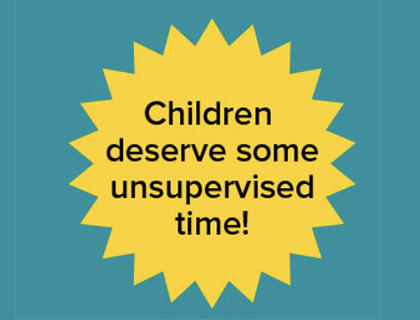On my show (3 episodes air tonight starting at 5:30/4:30 Central Time on Discovery Life), I give the children of very anxious parents a task to do that they seem ready for — even if their parents aren’t. They walk to school, make dinner, ride a bike.
And usually, when the parents see their kids suddenly competent and confident, the fear disappears, replaced by a surge of joy.
So: How would that work if a whole SCHOOL embraced the idea? Here’s my interview with Nancy McDermott, in SpikedOnline, the British version of Slate, or Reason. Read the whole piece here:
*
NM: What is the Free-Range Programme and how did it get started?
LS: Back in 2009, just after my son Izzy rode the subway and we were all over the newspapers and television, a teacher here in New York City called me to say she’d just had the kids in her class do a free-range project and wanted to know if I’d like to come along and see their presentations. So I went along and saw all the wonderful things these kids had done.
My favourite project was by an 11-year-old girl who decided to bake an ‘independence cake’. This meant she had to walk to the grocery store by herself, buy all the ingredients, walk back home and bake the cake.
On her poster she described walking the half mile to the store like this: ‘On my way there, everyone looked angry, like they might want to snatch me.’ But she got there safely, found all the things she needed, paid for them with her own money (because that’s what independent people do), then walked home and baked the cake. She wrote about the trip home this way: ‘It was much quicker and more pleasant because I was already used to the walk.’
It really just sums up how transformative one small act can be. She started out on her trip a little fearful, but on the way back, reality flooded in: the distance wasn’tshorter; the people weren’t nicer. What really changed is that she stopped seeing stranger danger everywhere and just saw her neighbourhood as it really was: filled with people, not abductors. I loved that story but it was only after a few years and doing the show that it finally dawned on me that if one class could do it, why not a whole school?
I had the idea when I was visiting a school in Menlo Park, California. The school had chosen ‘confidence’ as its motto for the year. There were all these posters up that read ‘What would you do if you weren’t afraid?’. So I asked them, why don’t you do a free-range project? I told them what I had in mind, the principal, the vice principal and the school psychologist all signed on, and that was that.
NM: How did it work?
LS: Every teacher in the school told each kid to go home and ask their parents if they could do one thing they felt they’re ready to do but haven’t done yet, for whatever reason. It could be something really simple, like walking the dog or going to get a haircut, or riding a bike to school — not extreme things like bungee jumping — just some activity that would have been considered normal a generation ago.
It was strictly voluntary, but knowing the school was endorsing it, a lot of the parents said ‘yes’. In the end, about a third of the 700 students at the school participated. We were also careful to present it as a one-shot deal. It didn’t mean making a commitment to letting their kids walk to school every day. They just needed to let them do it this once. But that ‘once’ changed everything.
So, for instance, there was one family, where the father was (unusually) more nervous than the mother. Their son, a 10-year-old, wanted to ride his bike to school but his dad said ‘no way’. But his son persisted and showed him the material I’d sent along explaining what the project was about. There was one line in it — actually something someone wrote on my blog — that went ‘all the worry in the world doesn’t prevent death; it prevents life’.
That line affected this father so much that he cut it out and posted it on the kitchen cabinet. Then he and his wife decided to compromise with their son. They told him he could ride his bike over to a friend’s house on a Saturday when there was less traffic. So he went, stayed a long time and came back so grateful and beaming with pride that his mom and dad were overwhelmed. When Monday morning rolled around, his parents looked at each other and said ‘why don’t we just let him ride his bike to school?’. And so he did for the rest of the school year.
Just one thing can have a knock-on effect. There was another kid whose project was to get his hair cut on his own. He came back with a Mohawk! His mother was furious — she hated, hated this haircut. But then she calmed down eventually and thought: ‘If he’s old enough to choose his own haircut, he’s old enough to do more around that house.’ And she started giving him more chores. She also decided to do her own free-range project where she looked at what she was doing for him, things that were a hassle for her, and just stopped doing them. In particular, she stopped doing his homework with him. His grades went down a little bit to start with, but he eventually got back into the swing of things and this time all the efforts were his own.
The ripple effect through the school was palpable. The school psychologist told me that parents were coming up to her asking if they could do it again and bragging about all the things their kids were doing: ‘my kid is making dinner’; ‘my kid is walking the dog!’. The dynamic had flipped so that instead of feeling proud about all that they could do for their kids, they became proud of what their kids could do for themselves. It really is that simple.
And another thing, when a whole school takes on a project like this, it has the potential to change a whole town and prevent parents being singled out. If there are enough kids out, doing things on their own, walking home from school or the playground, it becomes normal again. Busybodies no longer call up and complain to the authorities, as they did in the Meitivs’ case.
We need to stop the government telling us how to parent. The government is there to save children in danger: so if I’m starving my kid; pimping my kid; giving him drugs; beating him senseless — that’s what the government is there for — to save them from imminent danger. It’s not to say, ‘Oh, I wouldn’t do it that way’. That’s the government as mother-in-law, and nobody needs that.
NM: This all sounds great! Are there many schools involved in free-range programmes?
LS: So far there are projects in California, Texas, Virginia and New York, and I hope that more schools across the UK and America will get involved. And of course, they could have me come and speak. Either way it’s amazing how a complete sea change can come from one simple thing.
To Discuss Bringing The Free-Range Kids Project To Your School, Please Contact Judy Safern at Leading Thinkers: judy@leadingthinkers.com
Nancy McDermott is a writer and mother based in New York.




16 Comments
Ha, for the first time I wish my kids were in public school! I’d love to convince our neighborhood elementary school to do a Free Range project, and end up with more kids running around our neighborhood!
I love this!
Ah, so inspirational!
This is one of your best Lenore.
I read your blog every single day, and this is the coolest post I EVER remember. This is such great news, and such a great sign that change could come. I’m floored!
This is great. Finally, “Can do” instead of “Can’t do”.
And it reminded me that when I was in school, *only* the outcasts and weirdos were driven to school by their parents. Think on that a bit.
“It’s not to say, ‘Oh, I wouldn’t do it that way’. That’s the government as mother-in-law, and nobody needs that.”
Hands down, my favorite line.
Getting started with my 8th graders tomorrow with the prompt: “What would you do if you were not afraid?” Seems like a logical place to start! TY!
I just have to point out how much the free range philosophy meshes with the Montessori approach to education. I teach at a school where children ages 3-6 are taught how to begin doing things independently, the first steps to being ‘free range’. They learn to dress themselves, prepare snacks, clean up after themselves; things that a lot of children don’t begin learning until the elementary years or later. The confidence it gives them is superb, and I’ve had many parents come in and tell me how their child insisted on doing something themselves at home, rather than letting the adult do it. While most of these things are limited to the home (they are only preschoolers) it seems like a great start to building independence to me!
I’ve noticed that in the big European city where I teach, more kids are free to roam outdoors (even after dark) in the poorer areas, while kids in the richer areas are usually chaperoned.
There is a fair amount of street crime in both areas, but crimes against children are virtually unheard of. It’s possible that well-to-do parents confuse the realistic risk of property crimes with the unrealistic/unlikely risk of crimes against children.
You mentioned there are current free range projects in Virginia, where exactly? My family is located in Northern Virginia and I’m hoping it’s close to us!
You’re really making a difference. Keep on truckin’
Oh man, we need this at my daughter’s school in Carroll Gardens. At the urging of parents they now keep the gates to the school yard locked, which means a trip to my daughter’s class (in a trailer out back) is about 1/4 mile farther than it should be. Not fun when you’re schlepping the class pets home for the weekend. And yet the “security guards” will let anyone into the building who presents ID — they don’t confirm anyone is expecting you or even that you have a child at the school. And my ID is from out of state, which ought to be considered suspicious if anything is.
I’d love to see this at my kids’ school, although not many could get the “walk to school alone” thing unless parents dropped them off a mile or so away – it’s a charter school and many of the kids don’t live anywhere close to the school. But I know several kids who live in the neighborhood who are always escorted to the school. I walk with mine because my youngest is in kindergarten and still wants me along… although she usually runs off ahead anyhow. The school goes up to 8th grade and I know some middle schoolers in the neighborhood whose parents still walk them to and from the school.
Being more free range than the average in my neighborhood is starting to show results, though. My neighbor started out a couple years ago saying she couldn’t ever imagine letting her daughter walk to school alone or even just with my kids. Just a couple weeks ago, she gave her daughter permission to ride her bike around the neighborhood with my kids, and she’s thinking about using my 12 year old as a babysitter soon.
Aw, that’s nice. Would be cool if more schools did this.
Impressive. I’d never considered going to schools about this.
You’ve made a big impact on all those kids.
I do wonder how 2/3 of parents couldn’t find just ONE thing to let their kid do ONCE to satisfy the project, but those kids may still benefit from knowing they have peers who have just a little bit more freedom. An important step in gaining freedom is realizing where you don’t have it.